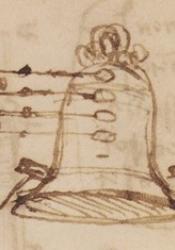Milan, Italy
Da Vinci moved to Milan from Florence in 1482, where he worked for the ruling Sforza family as an architect, painter, engineer, and sculptor. It was during these years in Milan that Leonardo wrote some of his most famous manuscripts, including his Codex Atlanticus. It was during his time in Milan between 1482 and 1499 that da Vinci created some of his famous masterpieces, including The Last Supper. It was also during this time that Leonardo recorded some of his greatest inventions, and recorded much of his writings about acoustics. Leonardo left Milan when it was invaded by the Frenh in 1499, but later returned from 1506- 1513.
Today, Milan is known as the leading financial center and a prosperous manufacturing and commercial city in Italy. Though Rome is the official and political capital of Italy, Milan is known as the "moral capital" because of the city's history and qualities, including Milan's success in numerous fields, and it's economical, cultural, and idealogical contribution to Italy. Milan is the richest city in Italy, and geographically connects Italy to the rest of Europe.
Vida, Stefania. “Tracing Leonardo Da Vinci's Milestones.” Where Milan, 5 July 2018, www.wheremilan.com/guide/leonardo-da-vinci-milano/.
Foot, John, and Alberto Lecco. “Milan.” Encyclopædia Britannica, Encyclopædia Britannica, Inc., 10 Jan. 2020, www.britannica.com/place/Milan-Italy/Landscape.
Parent Map
Coordinates
Longitude: 9.189982000000

